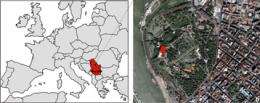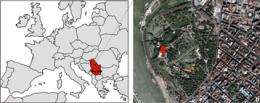Heritage site under attack by flowers

The results of a study conducted by Serbian researchers, in collaboration with the Laboratoire de Dynamique, Interactions et Réactivité, are unequivocal: the Belgrade fortress is not only threatened by the effects of coal burning, as was assumed until now, but also by flower beds. The deterioration of the fortress walls could be partially caused by the large quantities of potassium present in fertilizers used by gardeners and could be responsible for the formation of black crusts on the ramparts. To preserve this heritage, the researchers recommend avoiding excessive use of fertilizers. Their conclusions are due to be published in the first quarter of 2012 in the Journal of Cultural Heritage and could prove to be of value to other historical sites across the world.

In Belgrade, fortifications were built from the Middle Ages on the Kalemegdan plateau, which stands above the confluence of the Danube and Sava rivers. Today, the ramparts of the fortress of the Serbian capital have become a vast public park with flowers and shady areas, near the town centre, attracting inhabitants and tourists alike. However, during the last twenty years or so, black crusts have been spreading on its limestone walls. Until now, these crusts were solely attributed to the high levels of sulfur dioxide released by the coal heating used by the inhabitants of Belgrade.
In collaboration with Philippe Colomban, CNRS researcher at LADIR, the University of Belgrade and the Serbian Highway Institute analyzed the black crusts on the “King's Gate” of the fortress. Their objective was to determine the actual deterioration process in order to propose the most appropriate conservation solutions to the authorities. Different samples of the limestone and lime mortars were studied by porometry, X-ray diffractometry, infrared and Raman spectroscopy, electron microscopy and elementary analysis.
Above a certain concentration of sulfur dioxide in damp air, acid rain or acid fog can form. This leads to the emergence of “black” calcium sulfates and carbonates, giving the outer walls a somewhat unsightly appearance. Surprisingly enough, the researchers detected large amounts of syngenite, a double sulfate of potassium and calcium. This corrosion product normally forms on potassium-containing medieval stained-glass windows, as well as granite constructions or those using a mortar containing potassium. Yet it had never been observed on very pure limestone before. So where does it come from? After performing a series of analyses, the researchers revealed an abnormal concentration of potassium in the soil, near the rampart walls. Incidently, the latter contain flowerbeds where potassium-rich fertilizers are used. A simulation of the action of acidified potassium-charged water on pieces of limestone confirmed that it triggered the formation of syngenite, as observed on the “King's Gate”. Pretty flowers and monument preservation therefore require a subtle balance in potassium input in order to avoid such pollution. On-site measurements are scheduled to map the extent of the phenomenon.
More information: The origin of syngenite in black crusts on the limestone monument King's Gate (Belgrade Fortress, Serbia) – the role of agriculture fertilizer, Vesna Matovic, et al., Journal of Cultural Heritage (2011), doi:10.1016/j.culher.2011.09.003
Provided by CNRS
















